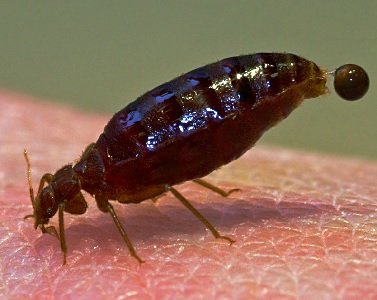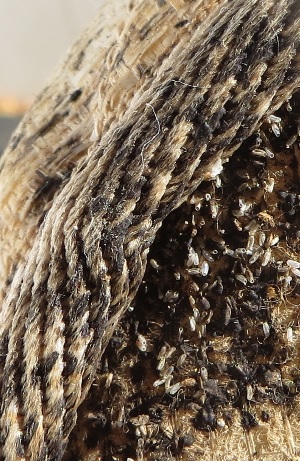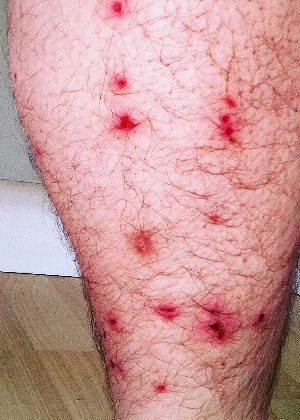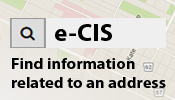Bed Bugs
- What are Bed Bugs?
- What do Bed Bugs feed on?
- How can Bed Bugs get into my dwelling?
- What would be considered evidence of Bed Bug activity if there are no eggs, nymphs or adults present?
- What do Bed Bug bites look like?
- How can I control Bed Bugs?
- How can I prevent Bed Bugs from entering my residence?
Bed Bug Links
Bed Bug Fact Sheet - En Francais
Provincial Grants and Prevention Materials Program
What You Should Know about Bed Bugs - Province of Manitoba
What are Bed Bugs?
Bed Bugs are "true bugs" that take blood meals mainly from humans, but will feed on other mammals. Generally Bed Bugs feed at night, but have been found to feed and be active during the day, usually near where a person may sleep or rest for long periods of time. The human Bed Bug or Cimex lectularius is the most commonly found species in homes, apartment buildings, hotels, etc. and can be found almost anywhere people inhabit. Bed Bug complaints and calls for information have been on the rise since the late 90's and are expected to increase as these insects are proliferating and disseminating at a rapid rate.

|
Adult Bed Bugs are large enough to see with the naked eye. They have oval-shaped bodies, when unfed, and range from 1.5 mm to 6 mm long (see Life Cycle below). Bed Bugs have a short broad head, flat thorax, and no wings. Despite having no wings, they can crawl quickly over floors, walls and ceilings. Bed Bugs can not jump or fly. Prior to feeding, they are flat; however, after feeding with their piercing sucking type mouthparts, they turn dark red and appear elongated and bloated.
A female is capable of laying 200 to 500 eggs, over her lifetime, depending on temperature and available hosts. The eggs are whitish in color and about 1 mm in size. Eggs are usually laid in small clusters in cracks and crevices. Their eggs are laid using a very sticky glue like adhesive to a site and are very hard to remove by hand. The eggs hatch in about 7 to 14 days depending on environmental conditions. The nymphal stage, which looks like a small adult, are the immature stage of the Bed Bug, and they need to start to feed immediately. They molt 5 times with each stage ranging from 14 to 30 days. The entire life cycle from the first instar/nymph to adult is typically 4 to 9 weeks, dependent of environmental conditions and availability of a host.
What do Bed Bugs feed on?
Bed Bugs prefer to feed on human blood, but will feed on other mammals if human hosts are not present. They usually feed (bite) at night when the human host is sleeping but if hosts are present during the day and are sedentary, Bed Bugs will be active during the day to feed as well. The bites are usually painless and often the bites will occur on the body where there are open areas of skin for the Bed Bug to feed on. Bed Bugs are very resilient to not having a human host always available and research has shown that they can survive 12 to 18 months without feeding, depending on the environmental conditions they are in.
Current research on Bed Bugs has never demonstrated that they are capable of transmitting or vectoring any human diseases. Most people are not aware that they have been bitten. However, some people are more sensitive to the bite and can have localized allergic reactions, often developing an inflamed spot. Often, a series of two to three welts or a line of bite welts produced in close proximity are present following feeding by Bed Bugs.
How can Bed Bugs get into my dwelling?
Bed Bugs are often transported into a dwelling on or in items such as used or discarded box springs, clothing, furniture, purses and luggage. Hotels, apartments, hostels, shelters or any other multi-unit dwelling are at risk. Most infestations start around beds and spread throughout a room and beyond. Bed Bugs are often found in the following areas (this not inclusive of all the possible areas that Bed Bugs can be present):

|
|
Bed Bugs can also travel (migrate) from room to room or apartment to apartment by moving along electrical wiring, pipes and other conduits if there is no food source present.
Adult Bed Bugs can survive without a blood meal for approximately 12 - 18 months dependent on environmental conditions. So if a room or home is vacated, it does not mean that the Bed Bug problem has been resolved due to their migration or by entering a hibernation like state until a host returns.
What would be considered evidence of bed bug activity if there are no eggs, nymphs or adults present?
If you suspect you may have Bed Bugs, inspect all the folds and crevices of mattresses and bed frames where Bed Bugs like to hide. You can monitor Bed Bug activity using double-sided sticky tape or glue boards and inspecting them daily. Bed Bugs leave dark reddish brown fecal matter in the areas where they have fed or their waste material during post feeding. If you are seeing these spots it may be an indicator of bed bug activity or a potential for Bed Bugs being present. As well discarded nymph casings and dark blackish fecal matter may also be present.
 Photo by Simon Berenyi under license CC BY 2.0 |
What do Bed Bug bites look like?When Bed Bugs feed, they inject their beak into the skin and their saliva acts as an anticoagulant to bring up the bloodmeal. Although individual responses vary, the common reaction is for the skin to become red, inflamed and irritated. Often the skin lesions are unnoticed or mistaken for flea or mosquito bites or other skin conditions. Rashes range from localized red and itchy spots arranged in a linear fashion. Some people may develop welts or a lump filled with fluid or blood. Bites occur on exposed areas of the skin, such as face, neck, hands, arms, legs or all over the body. Most Bed Bug bites will go away without treatment. If bitten, keep the the skin clean and avoid scratching. If bites are really itchy a doctor may prescribe cream, antihistamines or antibiotics if the skin has become infected from scratching. |
How can I control Bed Bugs?
Bed Bugs are difficult to control and require an Integrated Pest Management (IPM) program approach to suppress them. An IPM program combines various control techniques and products to minimize the risks to human health and environment.
There are non-chemical and chemical options for treating Bed Bug infestations.
Some non-chemical ways to treat Bed Bugs include:
- Place dry clothes into the dryer on high heat for a minimum of 15-20 minutes. This will effectively kill all stages, including the egg stage, without damaging the clothing.
- Alternatively, wash bedding and clothing in hot water (120oF) and laundry detergent.
- Use hot steam along baseboards, wallpaper, cracks or other areas where Bed Bugs and eggs can hide. Remember, if they can get into a space, they are likely there.
- Vacuum often with strong suction all possible places with Bed Bugs including the mattress, box spring, bedding and surrounding area. Scraping of the small grayish white 1 mm eggs has to occur to remove them. Vacuum daily and empty vacuum immediately and place into a sealed, tied up garbage bag and dispose of in the regular garbage.
- Use a scrub brush to remove Bed Bugs and eggs from the seams of mattresses.
- Stuffed toys can be put in the clothes dryer for a minimum of 15 to 20 minutes on high heat.
- If the material is heavily infested, seal up and remove the infested material and/or treat with a properly registered pesticide or hire an exterminator to treat your location (please see chemical treatment section below). If feasible and practicable destroy furniture, beds or bed frames that are suspected of having Bed Bugs so that they are unusable and dispose of in regular garbage. If possible treat the infested materials with heat above 120°F or 49°C
- Do not bring materials into a new location or from a location where Bed Bugs may have been present or are a current issue. Bed Bugs are easily and commonly transported from location to location on anything that can hold or hide bed bugs. This includes literally any household items, electronics, books that may have potential hiding spots.
- Treating materials that are infested with Bed Bugs by using cold temperatures (below 0°C) is NOT an effective method for control as the temperatures need to be well below what normal household freezers can provide. It can be used to slow down adults and nymphs so that materials can be properly washed, dried or vacuumed. Cold temperatures at this level will not be an effective control for killing eggs.
Chemical ways to treat Bed Bugs include:
- Domestic formulations of spray, liquid, and dust products such as Permethrin, Pyrethrins and Diatomaceous earth, are available at retail stores. All Pest Control products purchased and used must be registered with Health Canada and contain a Pest Control Product (P.C.P. or PCP) Number on their label. It is very important to ensure the products used are specifically registered for Bed Bugs. Directions for use of chemical products should be followed carefully and the amounts of products to be used on the label must be strictly adhered to. More does not mean it is better when using chemical pesticides. Do not chemically spray linens and mattresses unless they are registered for this use on the label.
Some Non-chemical monitoring options:
- Monitoring traps are an important part of determining if Bed Bugs are present or not. Use Double Sided Sticky tape to catch Bed Bugs. It is recommended that masking tape be used below or on any item such as carpet as it is difficult to remove without it.
- Sticky traps placed in areas along edges or corners where an individual sleeps. These traps will catch the 1st instar and up.
- Mattress Encasements, registered for Bed Bugs, can be used to trap Bed Bug stages and their eggs in the mattress allowing the owner to keep their mattress without having to replace it. DO NOT REMOVE ENCASEMENTS ONCE INSTALLED OVER MATTRESS AND/OR BOX SPRINGS.
- Bed Bug moats, pitfall traps or water and oil placed in a tin can with the bedpost will show evidence of Bed Bugs.
- If you are unsure, a Bed Bug dog could be called in to inspect your home.
Pest control professionals:
- For larger infestations, or for infestations in multi-unit buildings, pest control professionals should be called. Building owners should check municipal bylaws before trying to treat infestations on their own.
- Pest control companies often use a variety of chemical and non-chemical controls and products. More than one application will likely be necessary and the proper preparation of the home must be done to assist in maximizing treatments.
How can I prevent Bed Bugs from entering my residence?
Bed Bugs are on the increase and are being found just about everywhere. For large infestations, or for infestations in multi-unit buildings, pest control professionals should be called. Building owners should check municipal bylaws before trying to treat infestations on their own. To prevent a possible transfer of Bed Bugs to your residence a few tips are provided (this list is not all inclusive):
- When traveling take precautions by inspecting the room and furniture for bed bugs or signs of bed bugs. Protect your luggage by enclosing it in a plastic bag.
- Vacuum suitcases after returning from a vacation and put dry clothes into the dryer on hot for a minimum of 15-20 minutes. Put used vacuum bags into a sealed plastic bag and dispose of them immediately. Another option is to place into freezer for several days to slow the activity of the Bed Bugs, if present, then move to vacuum and laundry steps
- Be cautious when acquiring secondhand items such as beds, bedding, clothing, electronics, books and furniture. Be aware of what the signs of Bed bugs are. Even a tiny screw hole can harbour Bed Bugs.
- Repair cracks in plaster and glue down loosened wallpaper. Use caulking along baseboards and for any openings that a bed bug may use to travel from dwelling to dwelling.
- Remove and destroy wild animal roosts and bird nest when possible if located within the home, if Bed Bugs are identified.
- Check furniture and bedding regularly and keep normal cleaning and sanitation practices.


